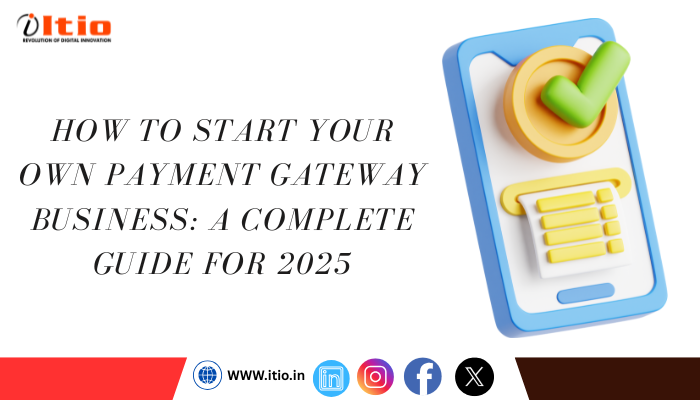In today’s digital-first economy, online payments have become second nature—from shopping and subscription services to bill payments and donations. Behind every seamless transaction lies a powerful tool: the payment gateway. It operates quietly in the background, ensuring transactions are secure, swift, and successful.
If you’ve ever wondered how to start your own payment gateway business, this comprehensive guide will walk you through the process, even if you’re a complete beginner.
What Is a Payment Gateway?
A payment gateway is a digital bridge that connects customers, merchants, and banks to process online payments. It acts as the secure middleman between a buyer’s payment method and the merchant’s bank, ensuring every transaction is encrypted, verified, and completed efficiently.
Why Start a Payment Gateway Business?
Starting a payment gateway business offers numerous benefits:
- Growing Market Demand – The surge in e-commerce and digital services creates constant demand.
- Recurring Revenue – Earn consistent income through transaction fees and service charges.
- Scalability – Start small and grow as your client base expands.
- Custom Control – Tailor your solution to meet the unique needs of different industries.
Step-by-Step: How to Start a Payment Gateway Business
1. Conduct Market Research
Understand the industry landscape by exploring:
- Services offered by leading payment gateways
- Your target customers (e.g., small businesses, e-commerce, SaaS providers)
- Regulatory and compliance requirements in your region
- Competitor strengths and weaknesses
This foundation will help you build a service that meets actual market needs.
2. Choose Your Business Model
Select the model that fits your goals and resources:
a) Aggregator Model – You act as a middle layer, allowing merchants to process payments via your platform.
b) White Label Payment Gateway – Rebrand a ready-made gateway solution as your own, ideal for fast deployment.
c) Custom Development – Build a unique payment gateway tailored to your business, offering maximum control and scalability.
Tip: White label solutions are great for faster time to market, while custom development is better suited for businesses seeking long-term differentiation.
3. Address Legal and Regulatory Requirements
Ensure your business is legally compliant by:
- Registering your company
- Obtaining necessary licenses (e.g., PCI DSS certification for data security)
- Opening a merchant account
- Preparing legal documents (Terms of Use, Privacy Policy, Refund Policy)
Consult with legal professionals to avoid costly missteps.
4. Build or Acquire Your Payment Gateway Platform
You have two primary options:
a) Custom Development – Hire a development team or software company to create a secure and feature-rich platform, including:
- API support
- Merchant dashboards
- Transaction monitoring
- Fraud prevention systems
- Multicurrency and multi-language support
b) White Label Solution – Partner with a provider offering a pre-built gateway that you can brand and customize.
Advantages of White Label Solutions:
- Faster launch
- Reduced development costs
- Ongoing technical support
5. Focus on Security and Compliance
Security is a non-negotiable priority. Your gateway must support:
- PCI DSS Compliance – Protects cardholder data
- SSL Encryption – Secures online communication
- Tokenization – Replaces sensitive data with secure tokens
- Fraud Detection Systems – Prevents unauthorized transactions
Maintaining a secure environment builds long-term trust with merchants and users.
6. Establish Banking and Processor Connections
To enable actual payment transactions, connect with:
- Acquiring banks
- Payment processors
- Card networks like Visa, Mastercard, and others
These relationships are essential for transaction authorization, fund transfers, and handling refunds or chargebacks. Begin these partnerships early in your setup phase.
7. Define Your Pricing Model
Establish a clear and competitive pricing strategy, including:
- Transaction fees (e.g., 2–3%)
- Monthly or setup fees
- Payout timelines
- Chargeback policies
Transparency is key to winning trust and maintaining long-term client relationships.
8. Launch and Promote Your Business
Get the word out with a strong launch strategy:
- Website – Clearly explain your services, pricing, and value proposition
- Content Marketing – Share blogs on payment trends, security tips, and business solutions
- SEO – Target keywords like “start a payment gateway” or “white label payment gateway solution”
- Online Ads – Use Google Ads and social media to reach potential clients
- Incentives – Offer discounts or free trials to attract early adopters
9. Offer Reliable Customer Support
Customer support is critical in the fintech industry. Ensure:
- 24/7 chat or phone assistance
- A self-service knowledge base
- Dedicated support for high-value clients
Responsive support helps resolve issues quickly and builds customer loyalty.
10. Continuously Improve
Stay competitive by constantly upgrading your offering:
- Add popular payment methods (e.g., wallets, UPI, BNPL)
- Build plugins for platforms like WooCommerce or Shopify
- Optimize system uptime and transaction speed
- Gather user feedback and refine features accordingly
The fintech space evolves rapidly—be proactive and adaptive.
Common Challenges to Expect
- Intense Competition – Established players dominate the space
- Banking Delays – Building relationships takes time
- Security Risks – Cyber threats require constant vigilance
- Regulatory Changes – Stay compliant across jurisdictions
A well-planned strategy and the right technology partner can help you overcome these obstacles.
Final Thoughts
Starting your own payment gateway business is a promising opportunity in a fast-growing digital economy. With the right combination of planning, technology, and customer support, you can build a scalable and trusted platform.
To succeed, remember to:
- Understand your market needs
- Select the right business model
- Ensure security and compliance
- Build lasting customer trust
- Partner with experts if needed
Whether you’re going for a custom-built solution or exploring a white label payment gateway solution, the key is to deliver value, reliability, and innovation.
Read More: P2P Crypto Exchange Development: A Comprehensive Guide




